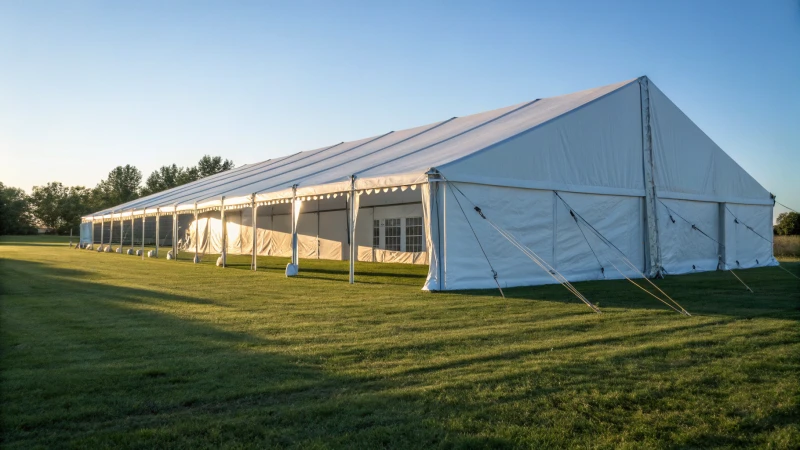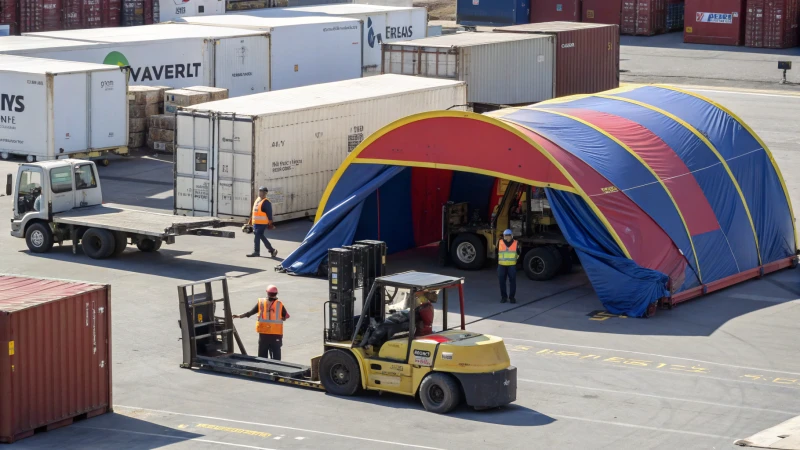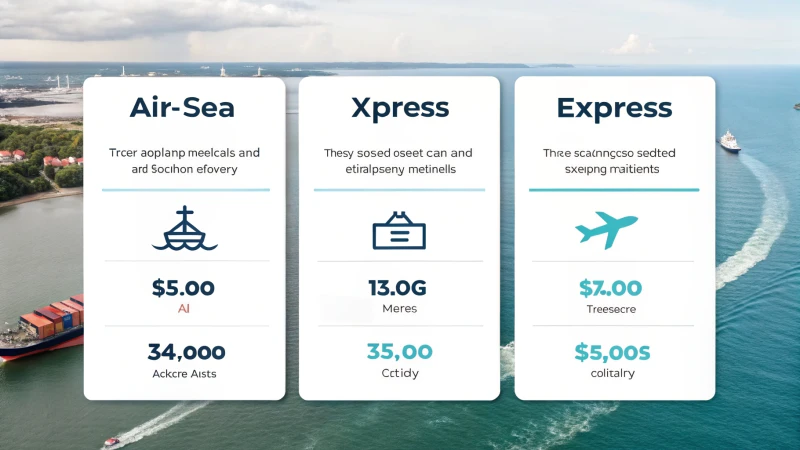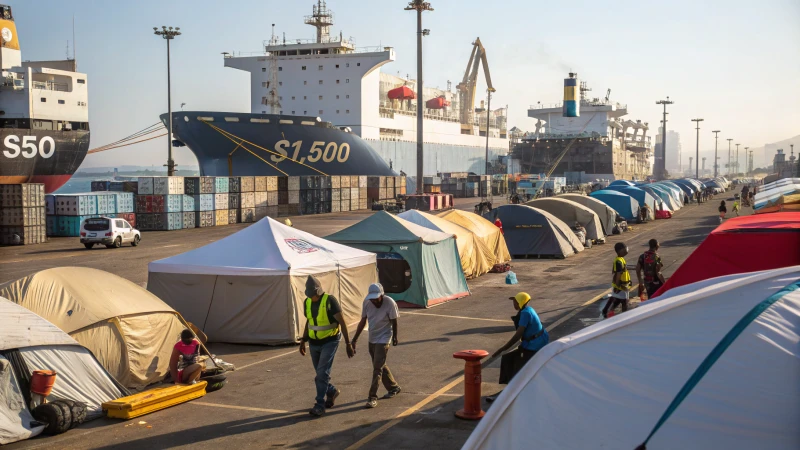
Remember the first time you had to arrange international shipping for a massive tent? It was an adventure! Let’s make sense of it together.
Shipping costs and lead times for international orders of warehouse or marquee tents depend on factors like tent size, weight, destination, and shipping method. Larger and heavier tents incur higher costs due to freight charges, while distant destinations may experience longer transit times.
I still recall the initial shock of discovering how many variables impact shipping. It’s not just about getting from point A to B; it’s the size, weight, and even the shipping method that can shift the entire budget. For instance, if you opt for air freight, expect a premium cost but a much quicker delivery. On the other hand, sea freight might save you some bucks but could test your patience with longer lead times. Let’s dive deeper into the specifics, unraveling these details to equip you with insights for making the best choices when those big tent orders come knocking.
Larger tents always have higher shipping costs.True
Larger tents incur higher freight charges due to their size and weight.
All international tent shipments have the same lead time.False
Lead times vary based on destination, affecting transit duration.
What Factors Influence Shipping Costs for Large Tents?
Ever wonder why shipping a large tent seems as complex as planning an expedition? Let me share some insights that might clear the fog.
Shipping costs for large tents depend on size, weight, destination, shipping method, and current logistics conditions. Larger and heavier tents typically incur higher costs due to increased freight charges.

Tent Size and Weight
Picture this: you’re eagerly awaiting a delivery, only to realize the tent you’ve ordered is more like a tiny house. The sheer size and heft of these massive structures—whether it’s a marquee or an industrial tent—significantly hike up shipping costs. I’ve seen it firsthand; larger tents demand more room, which translates into steeper freight charges. To give you a clearer picture, here’s a straightforward breakdown:
| Tent Type | Average Weight (kg) | Estimated Cost (USD) |
|---|---|---|
| Marquee | 500 | $1,000 |
| Warehouse | 800 | $1,500 |
And trust me, the weight doesn’t just affect your wallet; specialized handling may be necessary, adding another layer of cost.
Destination Impact
Then there’s the matter of where exactly these tents are headed. If your destination is off the beaten path, brace yourself for extra fees. I’ve had experiences where shipping from China to the U.S. was a whole different ball game compared to domestic routes within China. It’s all about accessibility—or lack thereof.
Shipping Methods
The method of shipping is like choosing between a sports car and a bicycle. Sure, air freight will get your tent to its destination faster, but it’ll cost you a pretty penny. On the other hand, sea freight is more like the budget-friendly option for bulky items, albeit slower. Here’s how they stack up:
| Shipping Method | Average Cost (USD) | Delivery Time |
|---|---|---|
| Air Freight | $3,000+ | 1-2 weeks |
| Sea Freight | $500 – $1,500 | 4-8 weeks |
Current Logistics Environment
In today’s world, where the logistics landscape is as unpredictable as the weather, events like port strikes1 or geopolitical issues can throw a wrench in your plans. Staying informed about these trends has saved me from many a headache.
Additional Considerations
- Customs and Duties: These are like those surprise hidden charges on your phone bill. Every country has its own set of rules and fees.
- Packaging Dimensions: Efficient packing can help dodge those pesky oversized fees.
- Insurance: It’s like putting on a seatbelt—better safe than sorry, especially for those high-value, custom tents.
By keeping these factors in mind and working closely with suppliers for detailed quotes, I’ve found that managing shipping expenses becomes less of an ordeal. If you’re keen to dive deeper into optimizing logistics strategies, check out these freight shipping tips2.
Larger tents incur higher shipping costs due to size.True
Larger tents require more space, leading to increased freight charges.
Air freight is cheaper than sea freight for bulky tents.False
Air freight is more expensive but faster; sea freight is cheaper for bulky items.
How Do Different Shipping Methods Affect Costs and Delivery Times?
Ever find yourself overwhelmed by shipping choices and their impact on your business? I’ve been there too. Let’s break down how different methods can affect your costs and delivery timelines.
Shipping methods like air, sea, and express each have unique impacts on cost and speed. Air freight is swift but pricey, sea freight is cost-effective but slower, and express services balance speed and cost.

Factors Influencing Shipping Costs
When I first ventured into international shipping for my tent business, the size and weight of each tent became crucial in determining costs. Larger tents, unsurprisingly, racked up higher freight charges3. The destination played a part too; remote areas often meant longer waits and bigger bills.
| Shipping Method | Cost Range (USD) | Delivery Time |
|---|---|---|
| Air Freight | $2,000 – $5,000 | 1-2 weeks |
| Sea Freight | $500 – $1,500 | 4-8 weeks |
| Express | $50 – $150 | 3-5 days |
Comparing Different Shipping Methods
Choosing Air Freight was like opting for the express lane—it was fast and perfect for those "must-have-yesterday" moments. However, the price tag was hefty. For high-value or time-critical shipments, it was a necessary expense.
On the flip side, Sea Freight felt like the slow but steady tortoise in the race. It was kinder to my wallet, especially for bulk orders. Planning ahead meant I could leverage these savings effectively. Shipping a large tent from the U.S. to Europe was dramatically cheaper via sea freight than air freight4.
Then there were Express Courier Services, my go-to for smaller shipments needing a quick turnaround without breaking the bank. They struck a nice balance.
Current Logistics Environment Impact
I’ve learned that staying informed about global logistics is crucial. Unforeseen events like port strikes or geopolitical tensions can throw a wrench in delivery plans, causing delays and hikes in costs. Flexibility in choosing shipping methods has often been my lifesaver.
Importance of Customs and Duties
Navigating customs duties and taxes was initially daunting. These vary wildly across countries and can inflate shipping expenses. Consulting with local customs authorities became a regular part of my process to avoid surprise fees that may apply5.
Air freight is the most expensive shipping method.True
Air freight costs $2,000 - $5,000, higher than sea or express.
Sea freight delivers faster than air freight.False
Sea freight takes 4-8 weeks, longer than air's 1-2 weeks.
What Are the Estimated Costs for Shipping Tents Internationally?
Have you ever tried shipping a tent overseas and found yourself scratching your head over the costs? I’ve been there, navigating this maze of logistics, and I’m here to share what I’ve learned.
Shipping a tent internationally can range from $50 to over $1,500 USD. The price depends on factors like the tent’s size, the destination, and whether you choose air or sea freight for shipping.

Factors Affecting Shipping Costs
When I first started shipping tents internationally, I quickly realized that it’s not just about the distance. There are several factors at play:
-
Tent Specifications: If you’ve ever tried fitting a marquee into a shipping container, you know the larger and heavier the tent, the steeper the cost. Once, I had to send a massive event tent across the globe, and the freight charges made my eyes water.
-
Destination: I remember shipping a tent from China to my warehouse in the U.S., and then sending another within Europe. The difference in cost was astounding. Shipping to remote areas often came with hidden fees due to logistics challenges.
-
Shipping Method: Opting for air freight might have your tent arriving faster than I could pack it, but it comes at a premium. Sea freight is easier on the wallet but requires patience. If you’re weighing options, comparing Air vs Sea Freight6 can be a lifesaver.
Estimated Costs by Shipping Method
| Shipping Method | Estimated Cost | Delivery Time |
|---|---|---|
| Air Freight | $1,000-$3,000 | 1-2 weeks |
| Sea Freight | $500-$1,500 | 4-8 weeks |
| Express Courier | $50-$150 | 3-5 days |
If you’re like me and need things done yesterday, express courier services might be your best bet for smaller tents. But for hefty orders, sea freight usually wins on cost.
Additional Considerations
-
Customs and Duties: I’ve learned the hard way that import duties can sneak up on you. It’s always wise to check with customs authorities beforehand.
-
Packaging: I can’t stress enough the importance of proper packaging. Insuring high-value items is crucial to avoid any heartache if damage occurs during transit.
-
Logistics Environment: Global events can throw a wrench in shipping plans. I keep an eye on Current Logistics Conditions7 to avoid nasty surprises.
Real-World Example
Take it from me: understanding all potential costs is vital. Once, I ordered a marquee tent from a U.S. supplier to the UK. The tent itself cost £485, and after shipping and duties, I ended up paying £609. The 13-day wait felt like an eternity.
For anyone navigating these waters like I have, engaging directly with suppliers for detailed quotes and timelines is invaluable. You’ll avoid unexpected expenses by having all the details upfront. Consider honing your Supplier Engagement8 strategies to improve negotiations and ensure smooth transactions.
Air freight is cheaper than sea freight for shipping tents.False
Air freight is generally more expensive than sea freight due to speed.
Remote areas incur additional shipping charges.True
Logistical challenges in remote areas often lead to extra costs.
How Can You Optimize Shipping for Better Cost Efficiency?
Ever found yourself wondering how those shipping costs seem to sneak up on you?
Optimizing shipping is about making smart choices—like picking the right carrier, negotiating rates, using tech tools for tracking, and opting for efficient packaging. By digging into your shipping data, you can keep tweaking your logistics until they’re just right.

Shipping costs can be a real pain point, can’t they? I’ve been there, staring at spreadsheets wondering where all the money goes. But the good news is, with a few tweaks, those costs can be managed effectively.
Choose the Right Shipping Carrier
Finding the right carrier feels a bit like matchmaking. I remember spending hours comparing different options, weighing the costs against delivery speed and reliability. You wouldn’t believe how much insight you can get just from reading reviews9 or industry reports. Once I found a reliable carrier, it felt like a weight had lifted off my shoulders.
Negotiate Shipping Rates
I’ll never forget my first successful rate negotiation. I felt like I’d won a small battle! If you ship frequently, don’t shy away from asking for volume discounts. Hiring a logistics consultant10 was a game-changer for me; they have tricks up their sleeves that can unlock hidden savings.
Utilize Technology for Tracking
Investing in tracking technology was one of the smartest moves I made. It gave me peace of mind and reduced customer complaints by providing real-time updates. If you’re not already using a system that integrates with your supply chain management system11, it’s worth considering.
Opt for Cost-Effective Packaging
Packaging isn’t just about protection—it’s also about efficiency. Switching to lightweight materials saved me a ton of money and made me feel better about my environmental impact. Even reusable packaging12 can offer savings if done right.
Leverage Data Analytics
Data is your friend when it comes to optimizing shipping. By regularly analyzing delivery times, costs, and return rates, I was able to spot patterns and make informed decisions. A data-driven approach13 keeps your operations lean and efficient.
Making these changes wasn’t overnight work, but each step I took made a noticeable difference in my bottom line. And as any business owner knows, those small victories add up!
| Strategy | Benefit |
|---|---|
| Carrier Comparison | Competitive pricing |
| Rate Negotiation | Lower shipping costs |
| Tracking Systems | Improved reliability and transparency |
| Cost-Effective Packaging | Reduced material costs |
| Data Analytics | Continuous process optimization |
Negotiating shipping rates reduces costs significantly.True
Frequent shippers can qualify for volume discounts, lowering costs.
Using heavy packaging materials is cost-efficient.False
Lightweight or reusable materials reduce shipping costs and impact.
Conclusion
Shipping costs and lead times for international tent orders vary based on size, weight, destination, and method. Air freight is faster but pricier than sea freight.
-
Learn about how port strikes can disrupt supply chains and increase shipping costs, aiding in better logistical planning. ↩
-
Discover expert tips on saving costs with freight shipping, crucial for managing large tent logistics efficiently. ↩
-
Understanding how tent size affects freight charges helps optimize shipping strategies for cost efficiency. ↩
-
Researching sea freight costs from the US to Europe reveals potential savings compared to air freight. ↩
-
Learning about customs duties helps anticipate total shipping expenses and avoid unexpected fees. ↩
-
Compare air and sea freight to find the most cost-effective option for your tent shipment. ↩
-
Stay updated on logistics conditions to anticipate delays or changes in shipping costs. ↩
-
Learn how to negotiate better terms with suppliers for international shipments. ↩
-
This link provides insights into choosing the best carriers, helping you compare services and costs effectively. ↩
-
Learn how logistics consultants can negotiate better rates and streamline shipping processes for cost savings. ↩
-
Explore how integrating supply chain management systems with tracking tech enhances operational efficiency. ↩
-
Discover materials that balance protection with cost-effectiveness, crucial for reducing shipping expenses. ↩
-
Understand how data analytics can improve decision-making and optimize shipping strategies. ↩






